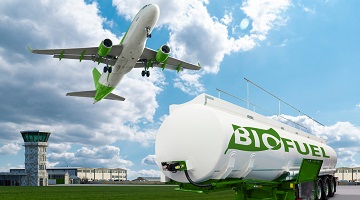
When rolled out and scaled up effectively, sustainable aviation fuel, or SAF, will be a critical component in the decarbonisation of aviation. SAF can emit up to 99 percent less carbon than Jet A-1 – but in order to take advantage of its potential, there are certain conditions that will need to be met before SAF can be considered a success.
Firstly, demand – the demand must be there from end users, i.e. airlines and aircraft operators. Secondly, supply – SAF production is distinct from regular jet fuel, and as such new facilities will be required to produce SAF at the scale needed. Finally, the regulatory environment must be supportive and enable the use of SAF wherever possible.
Proving the demand for SAF
Despite SAF currently representing a ‘green premium’ over regular jet fuel of anywhere between 2x and 5x, the good news is that airlines around the world have made clear their commitments to purchasing SAF. At the recent COP26 in Glasgow, airlines around the world committed to at least a 5 percent uptake of SAF by 2030 through the First Movers Coalition, while closer to home, UK aviation is committed to a 10 percent uptake by 2030. British Airways recently demonstrated their interest in SAF through an agreement with fuel producer Phillips 66, and Virgin Atlantic have similar targets in place.
To further increase the demand for SAF, ADS are supportive of a SAF Mandate, as proposed by the Government earlier this year. A SAF Mandate, with an effective price support mechanism such as a Contracts for Difference scheme, would be an effective tool to kickstart a SAF market. In combination with commitments from airlines, mandating a proportion of SAF usage – ADS are calling for 10 percent by 2030 – will provide a clear market signal to the SAF producers and suppliers.
Increasing the supply of SAF
With a clear demand signal for SAF in place, the attention then turns to ensuring a sufficient supply of SAF to fuel aircraft in the UK and around the world. The UK is home to several companies focussing on SAF, such as the aforementioned Phillips 66 and Velocys in Lincolnshire, Fulcrum BioEnergy in Ellesmere Port, Lanzatech in Port Talbot, and Nova Pangea in Redcar. These British enterprises will provide a variety of different SAF to UK airports – distributed through pre-existing pipelines – and as they continue to grow and develop will help grow a sustainable and green economy across the UK.
As you would expect, setting up new refineries, especially for new technologies like SAF, comes with high initial costs, hence why the demand signal is so important. But in addition to having confidence in demand, ADS has previously welcomed incentive programs such as Green Fuels, Green Skies, a DfT competition to reward £15m to SAF producers, alongside further commitments from the Government outlined in the recent Budget of an additional £180m. A combination of sufficient demand and government support demonstrates that the incentive is there for SAF production – and the more that is produced, the lower the price, thus increasing the demand. This virtuous cycle will be a key tool in the decarbonisation of aviation.
Keeping regulations and technology up-to-speed
United Airlines’ recently operated a demonstration flight between Chicago and Washington, DC with 100 percent SAF in one out of the two engines – keeping within the current regulation for use of SAF of a total blend of SAF and regular jet fuel of 50 percent SAF, as set by the American Society for Testing Materials, or ASTM, a standards body.
While this won’t be a problem until demand and supply ramp up drastically, approvals for 100 percent SAF flights will be crucial for maximising the benefits of SAF. ADS members Rolls-Royce and GE Aviation, two leading aircraft engine manufactures, are demonstrating that their engines will be able to run on 100 percent SAF, with Rolls-Royce targeting a 2023 date for full SAF compatibility for their Trent series of engines. Airbus, too, have been making big steps in this area – testing an A319 on 100 percent SAF, finding no difference in engine behaviour between SAF and regular jet fuel.
With sufficient demand, supply and innovation from ADS members, sustainable aviation fuels represent a real hope at moving the needle on decarbonising aviation. The Waypoint 2050 report sets out how, through a combination of ambition and investment, up to 1400Mt of carbon dioxide could be mitigated from global aviation through the ramp up of SAF usage. As COP26 demonstrated, the commitment of the aviation and aerospace industry to decarbonisation is clear – and SAF will be one of the most important levers available.





